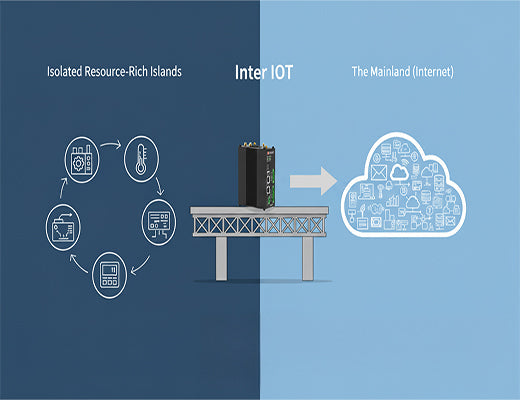
What is the Inter IoT? A Guide to Connecting Your Devices
|
|
Time to read 4 min
|
|
Time to read 4 min
You've probably heard the term Inter IoT or the "Internet of IoT," but what does it actually mean in a practical sense?
This guide is for anyone looking to understand the core challenge of the Internet of Things: how to reliably and securely connect physical devices to the digital world.
We'll break down the concept, explain the critical role of an Industrial IoT Gateway in bridging the gap, and walk through a real-world example. Discover how the Inter IoT is made possible by purpose-built hardware designed to bring your remote assets online.
I've spoken with countless engineers and project managers who have a clear goal: they have valuable data trapped in a remote machine, a sensor, or a PLC, and they need to get it to the internet for analysis. This fundamental challenge is the essence of the Inter IoT or Internet of IoT.
Think of your "Things"—your industrial machines, sensors, and controllers—as isolated, resource-rich islands. The "Internet" is the mainland, where data can be processed, analyzed, and turned into value. To unlock the potential of those islands, you need to build a robust, secure, and reliable bridge between them. A standard consumer router is like a rickety wooden bridge in a storm; it's not built for the job. The professional solution is an Industrial IoT Gateway, the purpose-built infrastructure that makes the Inter IoT a reality.

Let's be clear: most industrial devices were never designed to connect directly to the internet. They speak specialized languages like Modbus or connect via serial ports. An Industrial IoT Gateway is a smart, ruggedized device that acts as a translator and a communications hub.
A gateway like the Robustel EG5120 performs two critical functions to enable the Inter IoT:
Let's make this tangible. Imagine a legacy CNC machine on a factory floor.
This is the power of the Internet of IoT in action—turning isolated, offline assets into connected, intelligent sources of business value.

You might be tempted to use a cheaper, consumer-grade device to build your bridge. This is almost always a costly mistake. The industrial world is a harsh environment, and you need hardware that is built to survive.
An industrial gateway provides:

The Inter IoT is more than just a concept; it's a practical reality made possible by specialized, industrial-grade hardware. It's about creating secure and reliable bridges between your valuable operational assets and the powerful world of internet-based analytics and management. Whether you need to connect a single remote sensor or an entire factory floor, Robustel provides the secure and reliable gateways that serve as the essential bridge to the internet, turning the promise of the Internet of Things into a tangible asset for your business.
A1: M2M (Machine-to-Machine) was an earlier term focused on simple, point-to-point telemetry. The Inter IoT (or Internet of IoT) is a broader, more modern concept that includes not just data collection, but also edge computing, cloud integration, and sophisticated data analytics.
A2: No, and that's the key. An intelligent IoT gateway can connect to "dumb" legacy devices (like a simple temperature sensor with a Modbus output) and provide all the intelligence needed to translate their data and connect them to the internet.
A3: For most industrial applications, a cellular (4G/5G) connection using an industrial gateway with dual-SIM failover is the most reliable method. It is independent of local network infrastructure and provides built-in redundancy.